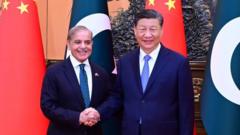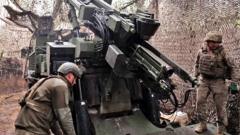### Summary: A recent four-day conflict between India and Pakistan has drawn attention not only to the military capabilities of both nations but also to the unexpected implications for China's defense industry. Analysts suggest that the use of Chinese-made aircraft by Pakistan might signify a pivotal moment in the global arms trade, enhancing China's credibility in military technology amidst ongoing geopolitical rivalries.
### Title: The Unseen Victor: China’s Gains Amidst the India-Pakistan Conflict

### Title: The Unseen Victor: China’s Gains Amidst the India-Pakistan Conflict
### Description: Amid the recent hostilities between India and Pakistan, China's defense industry is positioned to emerge as a notable beneficiary, showcasing its military technology on an international stage.
The recent four-day conflict between India and Pakistan, which concluded with a ceasefire, has left both nations claiming victory, but it is China’s defense industry that may emerge as a significant beneficiary. The clashes, which erupted on May 7, were ignited by India’s military response to a brutal attack in Kashmir that left 26 civilians dead, prompting what India termed Operation Sindoor.
In retaliation, both nations engaged in a series of military maneuvers involving aerial assaults using advanced fighter jets and drones. India’s air force utilized French and Russian aircraft, while Pakistan deployed its J-10 and J-17 jets, which are co-produced with China. Despite claims from Islamabad regarding the downing of Indian planes, including newly acquired Rafale jets, definitive evidence and assessments of the aerial engagements remain elusive.
Air Marshal AK Bharti of the Indian Air Force acknowledged the complexities of combat without confirming specific claims of aircraft losses. India emphasized its operational achievements, asserting the elimination of numerous terrorists and targeting militant headquarters linked to Pakistan.
Scholars suggest that the conflict marks a critical "DeepSeek moment" for China, akin to moments in technology where unexpected advances alter perceptions. Observers attribute the outcome of aerial combat to China's advanced military systems, pointing to a notable spike in the stock of the Chinese Avic Chengdu Aircraft company following the conflict.
While some experts caution against prematurely declaring Chinese weaponry superiority, pointing to the lack of comprehensive outcomes from the aerial skirmishes, analysts like Zhou Bo suggest the data from this different context may effectively advertise China’s military might. Chinese social media has seen a flood of nationalistic fervor celebrating these outcomes.
Nevertheless, previous criticisms surrounding the reliability of Chinese defense technology can’t be ignored, especially with concerns over past malfunctions in systems like the JF-17. The evolving dynamics of the India-Pakistan situation serve as a reminder of the growing military collaboration between Pakistan and China, with over $50 billion invested in infrastructure as part of the China-Pakistan Economic Corridor.
As India navigates these complex security dynamics, it faces an imperative to enhance its own defense production capabilities and strategies in response to the implications of this conflict. As the situation stabilizes, the ripples of this confrontation will likely influence the global arms market, especially regarding perceptions of Chinese military technology in the wake of its demonstrated performance during this recent encounter.





















